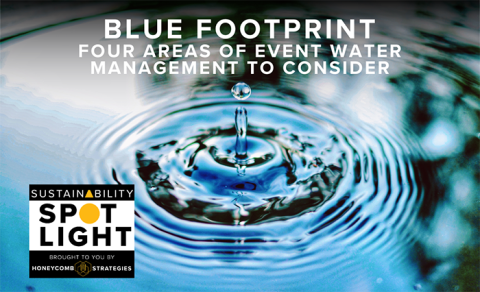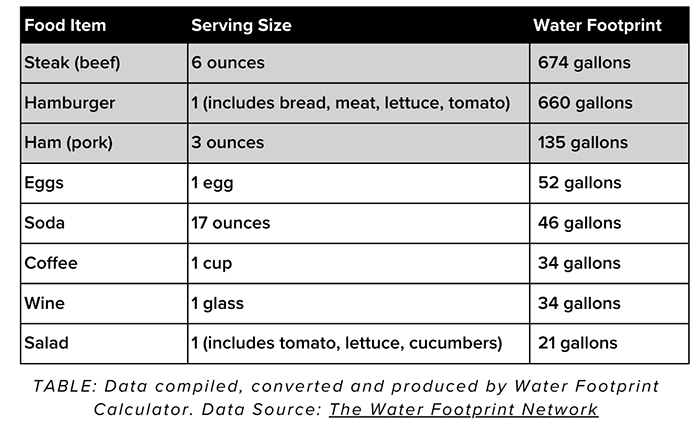Blue Footprint: Four Areas of Event Water Management to Consider

Exclusively sponsored by Honeycomb Strategies
Events need water! From flushing toilets to washing linens to serving drinking water and ice for happy hours, water is everywhere – but can often be overlooked when it comes to conservation measures. What, after all, can we really do to mitigate water consumption beyond measuring how much we used? Turns out there are a few ways. Let’s break down four ways to manage different types of water for your event.
Drinking Water Solutions
Safe and accessible drinking water is an important priority for the wellness of your event attendees. One convenient way to manage potable water is if your venue is stocked with water refill stations; communicate their location and make sure attendees know to pack their reusable water bottle.
If the facility has limited refill stations, we recommend partnering with a sponsor to bring bubblers and water stations to the event. Water stations and receptacles like souvenir bottles and cups are brand opportunities, and you can locate refill stations in high traffic areas (like a sustainability hub or wellness lounge) to increase visibility.
No matter what, we recommend banning plastic water bottles and other single-use plastics. The harm they cause through waste, micro-plastic contamination, ocean pollution, and exclusionary price gouging is well-documented and outweighs the convenience.
Pro tip to go the distance: You can extend the single-use plastic ban to include move-in and move out!
Look at Water Practices at your Venue
If water management is a priority, vet your venues for their equipment, standards, and policies. Ask to read the building’s environmental operations policies, including any water-specific ones. Make sure that building operations can measure and provide an accurate measurement (or at least, a responsible estimate) of the event’s impact while on site.
You can ask about the flush and flow rates of the restroom fixtures and fittings – ideally toilets use no more than 1.28 gallons per flush and faucet a maximum of 1.5 gallons per minute – as well as sensors and other upgrades for efficiency. Inquire if appliances like toilets, urinals, and kitchen equipment are labeled WaterSense, which would contribute to lower water usage throughout the building.
It’s best to ask these questions ahead of time, while you’re shopping for venues for future events, as many of these changes can’t be implemented in a short span of time. If you’ve already contracted with a venue, it doesn’t hurt to follow up with them now to ask what is in place and what to expect – this can help you set realistic expectations for your water footprint.
Pro tip to go the distance: You can ask hotel partners these same questions!
Food and Beverage
“Invisible water” is the term often used to describe how much water it takes to grow or make something. Water-conscious events will want to keep this in mind when planning catering menus and partnering with food and beverage vendors.
We can see from this table that animal products have a far higher water footprint than anything plant-based. That’s because invisible water for any animal product accounts for (1) the water consumed by the animal, (2) the water to grow the plants that they eat, and (3) the added water for cooling, cooking, etc; a plant-based item only has to account for the latter two.

What’s more, factory farm or feedlot-raised animals eat feedstock from corn and soy, and corn is the most heavily irrigated crop in the U.S. Free range animals eat wild plants that are nourished by rainwater, so the invisible water footprint of free range meat decreases.
But it’s not just meat and animal-based products. By sourcing from local farmers and farm-to-table vendors, you’re increasing the likelihood of using produce that is seasonal and flourishes in its native climate without needing extra irrigation (or energy). The plus side is these fresh, local and seasonal items will taste better, providing an exceptional experience for your event as well as conserving water.
Balance Water Usage with Water Restoration Certificates
Water Restoration Certificates (WRCs)® from the Bonneville Environmental Foundation (BEF) offer a unique approach to restoring water to critical ecosystems, ensuring that your water footprint is actively mitigated.
If you’re familiar with carbon offsets or Renewable Energy Certificates (RECs) you already understand the model for WRCs. The water you use at your event equals an equivalent investment in projects to protect and restore water habitat, bodies of water, and access to water.
Theoretically, you should be purchasing a one-to-one ratio of gallons used to gallons restored. However, it can be challenging to get an exact number for water usage for the duration of an event and you might have to estimate. Another option is to make an educated commitment based on number of attendees, such as 1,000 gallons per participant, or to commit to a flat rate.
Savor Each Drop
As with all sustainable improvements, these management strategies take time and planning. As part of a holistic event strategy, you can build on a water management strategy one step at a time to find a pace that makes sense for your team. But don’t take water or its costs and impacts for granted; while it may often be invisible, it’s also essential. To make responsible choices, begin with measurement and adopt mitigation, reduction, and balance strategies that align with your values.
Honeycomb Strategies specializes in impactful solutions for sustainable events, sports, and venues. hcsustainability.com/hello@hcsustainability.com


Add new comment